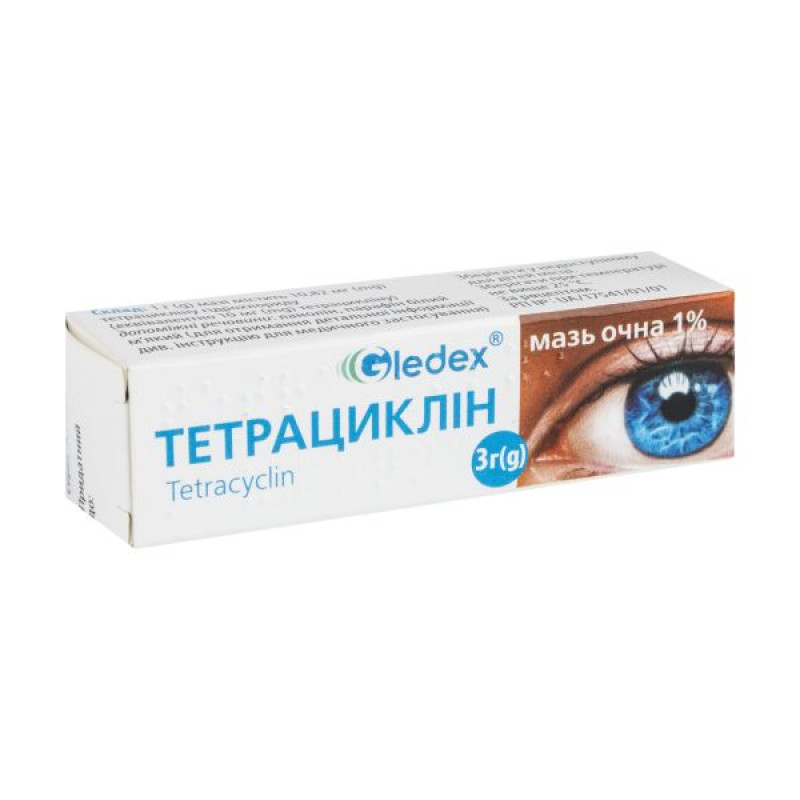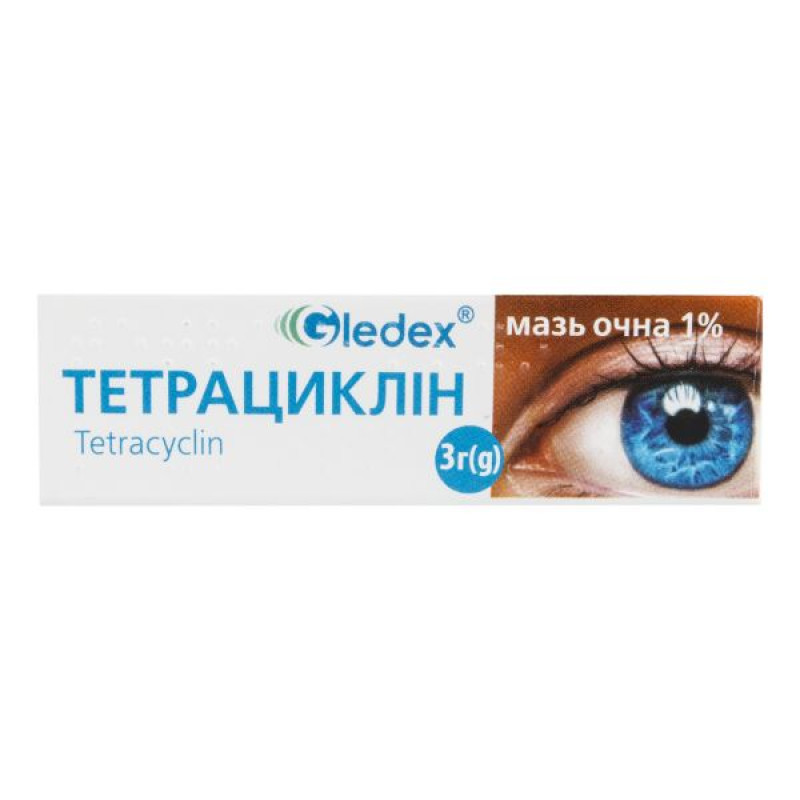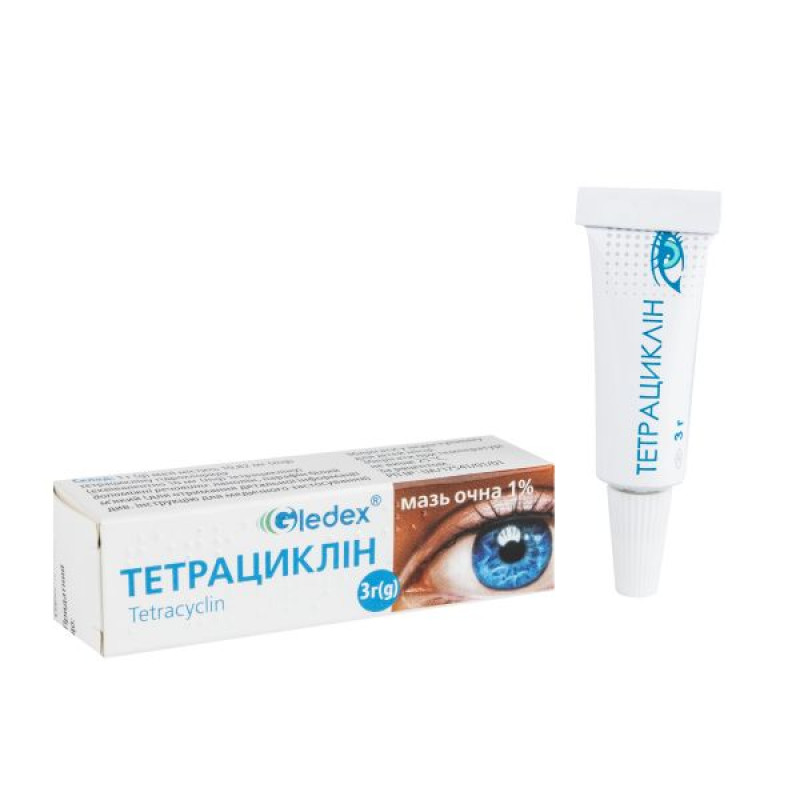Tetracycline eye ointment 1% tube 3 g

Instructions Tetracycline eye ointment 1% tube 3 g
Composition
active ingredient: tetracycline hydrochloride;
1 g of ointment contains 10.82 mg of tetracycline hydrochloride (equivalent to 10 mg of tetracycline);
excipients: lanolin, white soft paraffin.
Dosage form
Eye ointment.
Main physicochemical properties: ointment of uniform consistency from yellowish to yellow.
Pharmacotherapeutic group
Means acting on the sensory organs. Means used in ophthalmology. Antimicrobial agents. Antibiotics. ATX code S01A A09.
Pharmacological properties
Pharmacodynamics
Bacteriostatic antibiotic from the tetracycline group. Disrupts the formation of a complex between transfer RNA and the ribosome, which leads to disruption of protein synthesis.
Active against gram-positive and gram-negative microorganisms - Staphylococcus aureus, Streptococcus epidemicus (Streptococcus pyogenes), Streptococcus pneumoniae (Diplococcus pneumoniae), Neisseria gonorrhoeae, Haemophilus influenzae, Haemophilus ducreyi, Klebsiella pneumoniae, Francisella tularensis (Pasteurella tularensis), Yersinia pestis (Pasteurella pestis), Escherichia coli, Bacillus anthracis, as well as Chlamydia trachomatis.
Ineffective against some strains of Haemophilus influenzae, Klebsiella spp., Aerobacter spp., Pseudomonas aeruginosa, Serratia marcescens.
Pharmacokinetics
With topical application, systemic absorption is low.
Indication
Infectious eye diseases: conjunctivitis, keratitis, blepharitis, trachoma.
Laboratory confirmation of the susceptibility of microorganisms in samples collected before treatment should be performed.
To reduce the development of resistant bacteria and maintain the effectiveness of tetracycline and other antibacterial drugs, Tetracycline should be used only to treat infections that are proven or suspected to be caused by bacteria susceptible to it.
Contraindication
Hypersensitivity to tetracycline or similar antibiotics (doxycycline, metacycline, oxytetracycline) and excipients listed in the "Composition" section. Fungal diseases, lupus erythematosus, deep or puncture wounds, severe burns, long-term use in liver or kidney diseases, leukopenia. Pregnancy and breastfeeding. Children under 8 years of age.
Interaction with other medicinal products and other types of interactions
When topically using tetracycline in ophthalmology, it should be borne in mind that its bacteriostatic action may interfere with the bactericidal action of penicillins, cephalosporins, and aminoglycosides. Their simultaneous use, both topically and systemically, should be avoided.
The use of tetracycline in patients using contact lens solutions containing 0.004% thiomersal has been associated with ocular reactions of varying severity (eye redness, irritation, blepharitis). Some patients who used tetracycline concomitantly with ophthalmic preparations containing thiomersal have experienced ocular inflammation. The concomitant use of tetracycline with medicinal products and/or contact lens solutions containing thiomersal should be avoided.
The concomitant use of ophthalmic tetracycline and topical corticosteroids should be avoided (see section "Special warnings and precautions for use").
To increase effectiveness, it can be used in combination with erythromycin, oleandomycin, and nitrofuran drugs.
You should not use cosmetics containing retinoids while using tetracycline.
Application features
If the patient's condition does not improve within several days of use, it is necessary to consult a doctor regarding further use of the drug.
Concomitant ophthalmic use of tetracycline and topical corticosteroids (dexamethasone, prednisolone, hydrocortisone) should be avoided because of the possibility of masking the clinical signs of bacterial, viral, or fungal infections. Corticosteroids may suppress hypersensitivity reactions to tetracycline.
Like other antibacterial drugs, with prolonged, repeated use, when used simultaneously with other antibacterial drugs, tetracycline may lead to overgrowth of non-susceptible strains of bacteria or fungi. In the event of superinfection, it is recommended to discontinue use of the drug and conduct appropriate treatment.
Due to the possible development of photodermatoses (increased photosensitivity when using tetracycline antibiotics), the drug should not be used in sunlight or under the influence of UV radiation.
Tetracycline should be discontinued at the first appearance of skin rash or other signs of hypersensitivity.
Patients should not wear contact lenses if they have an eye infection.
Since the medicinal product contains lanolin as an excipient, it may cause local skin reactions (e.g. contact dermatitis).
Use during pregnancy or breastfeeding
The efficacy and safety of the drug during pregnancy or breastfeeding have not been sufficiently studied, so it should not be used in this category of patients.
Ability to influence reaction speed when driving vehicles or other mechanisms
As with all ophthalmic agents, temporary blurred vision or other visual disturbances may occur, which may affect the ability to drive or use machines. Patients should refrain from driving or using machines until visual acuity is restored.
Method of administration and doses
Dosage.
Depending on the severity of the condition, a strip of eye ointment 1–1.5 cm long is applied to the conjunctival fold of the lower eyelid 3–4 times a day, in more severe cases – up to 6 times a day.
The duration of treatment is determined by the doctor and is usually 5 to 7 days. After symptoms have subsided, treatment should be continued for another 2–3 days. For more severe eye infections, acute or chronic trachoma, the course of treatment may last up to 1–2 months, and tetracycline can be combined with oral antibiotics.
When used simultaneously with other ophthalmic drugs, the interval between applications should be at least 10 minutes, and the eye ointment should be applied last.
It is very important to practice hygiene when applying eye ointment, so you should not touch your eyes or surrounding surfaces with the tip of the tube.
Method of application.
1. A strip of eye ointment (1–1.5 cm) is carefully applied to the conjunctival sac of the affected eye so that the tip of the tube does not touch the eyelids or surrounding surfaces.
2. Close the eyelids for 1–2 minutes and move the eyeball in different directions to transfer the medicine over the entire surface.
3. Remove excess ointment from eyelids and eyelashes with a clean tissue. Wipe the tip of the tube with another clean tissue and close tightly.
4. If it is necessary to apply tetracycline to the other eye, repeat all the described steps.
Children
Do not use for the treatment of children under 8 years of age.
Overdose
With topical application, cases of overdose have not been described.
Adverse reactions
The following adverse reactions have been reported to be of moderate severity and resolve rapidly after discontinuation of treatment.
On the part of the organs of vision: blurred vision, acute pain, itching of the eyes or eyelids, conjunctival hyperemia, irritation of the mucous membrane of the eyelids, eyelid edema, increased tearing and eye pain. Myopia in patients using tetracyclines may be caused by temporary hydration of the lens.
On the part of the immune system: local allergic reactions - dermatitis, rash, itching, burning sensation, inflammation, photodermatitis (increased sensitivity to sunlight and UV radiation); generalized allergic reactions, including rash, fixed drug rash, exfoliative dermatitis, angioedema, itching and swelling of the face, tongue, throat, dizziness, shortness of breath. In such cases, the use of the ointment should be discontinued.
On the part of the gastrointestinal tract: decreased appetite, nausea, vomiting, diarrhea, possible inflammatory processes in the tongue area, stomatitis, gastritis, proctitis.
Infections and infestations. Candidiasis (growth of Candida albicans), overgrowth of resistant coliform organisms (Pseudomonas, Proteus) may occur.
General disorders: Cases of increased muscle weakness in patients with myasthenia gravis and exacerbation of lupus erythematosus have been reported with prolonged use of tetracycline.
Reporting of suspected adverse reactions.
Reporting adverse reactions after the registration of a medicinal product is important. This allows monitoring of the benefit/risk ratio when using this medicinal product. Medical and pharmaceutical professionals, as well as patients or their legal representatives, should report all cases of suspected adverse reactions and lack of efficacy of the medicinal product via the Automated Information System for Pharmacovigilance at the link: https://aisf.dec.gov.ua.
Expiration date
3 years.
Storage conditions
Store at a temperature not exceeding 25 ̊C.
Keep out of reach of children.
Packaging
3 g or 10 g in tubes, 1 tube in a cardboard pack.
Vacation category
According to the recipe.
Producer
LLC "Arpimed".
Location of the manufacturer and address of its place of business
Kotayk region, Abovyan city, 2nd microdistrict, building 19, Republic of Armenia.
There are no reviews for this product.
There are no reviews for this product, be the first to leave your review.
No questions about this product, be the first and ask your question.





